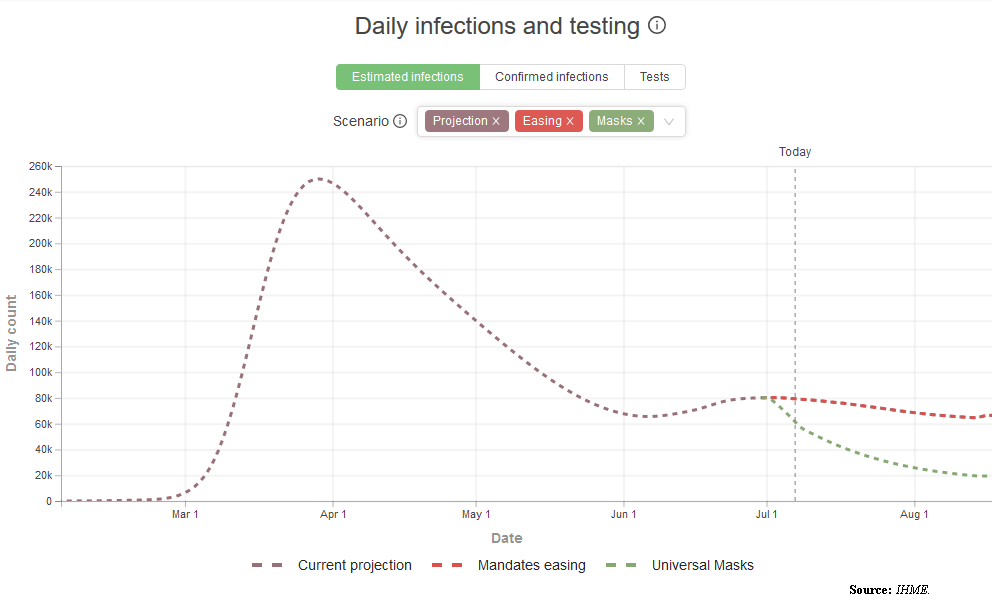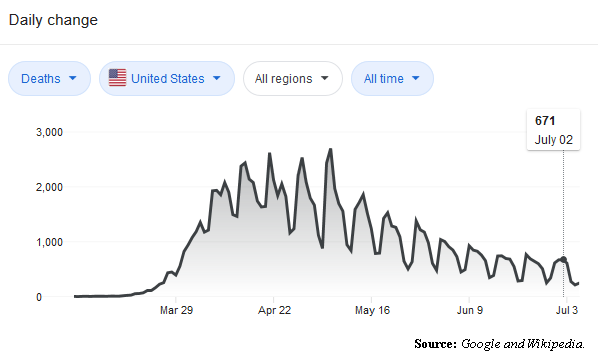The number of daily deaths from the China-originated COVID-19 pandemic continues to drop from its peak in May, when deaths topped 2,700 on certain days, to 671 on July 2, even as the number of confirmed cases sees a temporary increase as several states proceed with reopening from their shutdowns.
This has led to many alarmist headlines like this one from the Washington Post, “Coronavirus updates: Seven-day average case total in the U.S. sets record for 27th straight day.” But they aren’t worth the paper they’re printed on.
The true number of cases has steadily fallen from its peak at the end of March with a slight uptick in June that’s already abating, according to the Institute for Health Metrics and Evaluation (IHME) model. Estimated COVID-19 cases reached almost 250,000 a day on March 29 and have fallen all the way to an estimated 68,000 today.
So it’s more fake news, with outlets leaving out the most important part, which is that even with the current slight uptick in confirmed cases, the pandemic of actual cases peaked more than three months ago.
Deaths are down.
Similarly, hospital usage is slightly elevated in the past month but is nowhere near the peak that was seen in April.
Objectively speaking, the worst is past us.
President Donald Trump blasted the news coverage of the virus in a tweet on July 6, saying, “New China Virus Cases up (because of massive testing), deaths are down, ‘low and steady’. The Fake News Media should report this and also, that new job numbers are setting records!”
President Trump is right. Anyone saying there’s a “record” number of daily new cases right now is lying. The peak was at the end of March. We know that.
The trends are still relatively on their way down, and IHME does not project they will rise again until September and October when the cold and flu season begins anew as should be expected.
One caveat on those projections has to do with whether masks are worn universally or not. IHME says that if masks are worn universally, by November, right before the election, there would be 32,000 new cases a day. If there are no masks, new cases would approach 240,000 a day.
The truth will be somewhere in between, and so the current project says 167,000 new cases a day by November.
But even in the baseline scenario, IHME only projects about 800 new deaths a day by November, undoubtedly owing to innovative treatments and cures that are significantly lowering the mortality rate for the virus across the board. In the UK, the mortality rate for those hospitalized has dropped from 6 percent to 1.5 percent, according to the University of Oxford.
In the meantime, hospitals are fully stocked and are prepared for the next cold and flu season like they were not last time.
Obviously, any vaccine would be a game changer between now and then in terms of the outlook.
So, where we stand right now might be about as well as can be expected. After months of lockdown, states and peoples are gradually reducing restrictions. Where there have been upticks in the number of cases, like in California, Texas, Florida and Arizona in the south, states have reinstated some restrictions.
To that end, the White house convened a summit on safely reopening schools yesterday and is more than welcome. The lessons being learned now will undoubtedly advise how states proceed with their plans in schools and other facilities this fall while we wait for the vaccine.
When they do reopen, states will monitor the number of cases very closely, and make course corrections along the way in the event of major outbreaks. We’re not out of the woods yet but the good news is that the mortality rate for the virus is steadily dropping.
Robert Romano is the Vice President of Public Policy at Americans for Limited Government.










